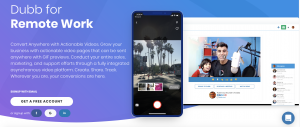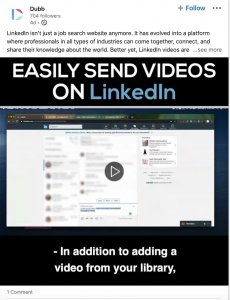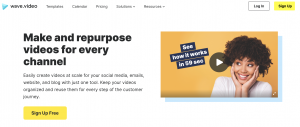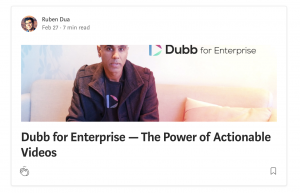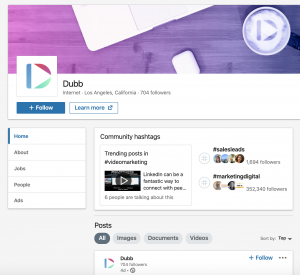Social media marketing in 2020 presents plenty of opportunities for small and large businesses alike. We’re blessed with a wealth of tools at our disposal—most of which are free. That said, this large number of tools at our disposal may lead to analysis paralysis. Moreover, there are always new things to learn about the social media marketing tools that we do use (including Dubb).
To better learn how to use social media marketing in 2020, I was pumped to speak with Josh Goldstein. Josh is an attorney who specializes in immigration law. He helps his clients from everything to obtaining green cards and work visas to the formalities in becoming a U.S. citizen.
Josh does amazing work and has helped countless numbers of clients. Being an immigration attorney is difficult work and Josh and his colleagues burn the candle to consistently achieve stellar outcomes. But along with achieving huge wins for his clients, Josh has to wear his “business” hat and promote his firm.
Ultimately, he has come a long way in kick-starting his social media marketing efforts as an attorney. Josh leverages social media marketing to get in touch with clients (or potential clients) and solve issues that they are facing. He is always learning and loves learning about new methods or strategies to improve his social media marketing work.
In my conversation with Josh, you will see that we touched on a range of subjects related to social media marketing. Because of this, I wanted to share some of the most interesting insights from our conversation. You’ll definitely want to consider how each of these insights applies to you and your organization. Nonetheless, by implementing some of these insights, I believe that you’ll see some promising results by relying on these insights in your day-to-day marketing work.
Feel free to watch the entire conversation by clicking on the video below:
Before we get started, you’ll notice that this conversation occurred on StreamYard. Streamyard is a great way to hop on video calls and share your screen with others. At Dubb, we have entered into a partnership with StreamYard, so click here if you would like to get a 14-day free trial.
Remote Work and Social Media Marketing in 2020
One of the first things that came up in our discussion was the value of video amidst COVID-19. The coronavirus has disrupted nearly every aspect of our lives. Even if you haven’t been infected, COVID-19 has forced nearly all of us to work from home. Our sense of normalcy has been disrupted, causing us to think of different ways to get our work done while we’re away from the office.
Since he has been working from home, Josh has embraced the power of video. Working from home is a new experience for Josh, yet he has found video to be a terrific way to connect with his clients. It helps him continue to provide value to his clients—even if he can’t meet with them face-to-face. In fact, Josh has set aside a certain area of his home where he can shoot and create as much video content as possible.
When someone asks Josh a question, he often responds in the form of a video. His overall goal is to be prolific and create a substantial amount of video content. That said, providing value is much more important to him than pure marketing. He wants to make his clients and audience’s lives better, whether that is through education or actual legal advice for his clients.
Josh is one of many individuals who have seen the power of video in a world that is increasingly embracing the work from home movement. At Dubb, we want to arm you with all of the tools you need to capitalize in this remote-first world. This is why we are so pumped about Dubb For Remote Work. Dubb For Remote Work is a collection of features that let you capitalize on video marketing—wherever you are.
Dubb For Remote Work lets you take advantage of many of the features that make Dubb great, including a wealth of call-to-action options, automatically generated landing pages, and more. Even so, with Dubb For Remote Work, you can capitalize on even more features and benefits, like YouTube and Asana integrations, a killer mobile app, and Dubb chat.
To view all of the features that come with Dubb For Remote Work, go ahead and click on the image below:
In sum, I think that the work from home movement is going to persist—even after COVID-19. Whether you choose to leverage Dubb For Remote Work or simply want to create more professional videos away from the office, I believe that you will be well-prepared for the future.
Sharing Social Media Posts Over Different Platforms
When discussing social media marketing in 2020, it’s important to touch on scheduling social media posts. Yes, you will want things like content calendars to make the process much smoother. Even so, one of the issues that small and large businesses encounter is how to actually share their content across different platforms. There are plenty of tools out there (like Buffer, Agorapulse, or Hootsuite) that can make scheduling and sharing your posts a breeze.
Nonetheless, as Josh asked me, there is this question of whether we are punished by using a scheduling service like Buffer or Hootsuite. The problem comes down to native sharing. It’s a common question, as many creators and marketers are concerned that they won’t get the same engagement as if they manually shared their post on the social network(s).
To start things off, social media automation is critical for all businesses. It’s especially critical if you are a solopreneur or have a small team. It takes time to post high-quality content and you don’t necessarily want to be on social media platforms throughout the day. The advantages of doing this are that you can pre-schedule everything and save time in the long run. But one disadvantage is that you may miss out on certain native features on these social networks (like certain aspect ratios that are essential to platforms like Snapchat or LinkedIn). Moreover, these platforms won’t necessarily promote your externally-linked content.
So what do you do?
If you create a Dubb video URL, we don’t recommend that you use the link in a social post. You won’t get as much engagement as you would if it was a native video. Instead, we recommend that you download your Dubb app, desktop, or screen recordings and upload it natively into your selected social network(s).
Forced to make a choice, I would probably say that you want to use video in its native format across all channels. However, if you have found through extensive A/B testing that you’re getting the same (or more) engagement through an automated tool like Buffer or Hootsuite, go ahead and stick with it. As with many things in video marketing, it’s all about experimentation and iteration.
Along with this, I think that the benefit of going native on every channel is that you can embrace the features and formats that are most relevant. For example, on LinkedIn, square videos perform better than 16×9 videos. It is a better experience for LinkedIn users who are watching your video on their cell phones. Square videos, which have a 1×1 ratio, take up more of the screen, and users don’t see the next post that’s below your post.
Ultimately, I’m a huge proponent of square videos not only on LinkedIn, but on Twitter, Facebook, and Instagram. The only problem is that it is hard to export them. They aren’t exported natively. At Dubb, we built a tool that can let you export your video into a 1×1 format, but it requires transcoding. If you still aren’t able to get 1×1 videos, 9×16 videos are ideal for platforms like LinkedIn, Twitter, Instagram, and maybe Facebook. If you can’t do that, then opt for 16×9.
Audio, Captions and the Power of Meme Text
At Dubb, we love meme text videos. Essentially, these are short videos that have some sort of text on the top (and/or bottom) of the video. An example is below:
Meme text videos get a lot of engagement for social media marketing in 2020 because they provide context. Viewers can quickly understand what the video is about and how it is going to create value in their lives. These videos are also easily shareable, allowing your followers and fans to spread the word about your product and organization.
If you want to create meme text videos of your own, I recommend that you use a tool like wave.video.
There are also other platforms like this. Essentially, what you do is upload an MP4 file to the platform and add relevant text. It’s that simple.
Meme text videos are also helpful because they capitalize on a larger point. Unless your video is on YouTube, your video’s audio will be off by default. Because of this, you’ll want to draft and incorporate captions. As a starting point, you’ll want to draft an informative caption above your video. Provide value first and stick within the character limits that the social network requires. If you don’t have time to write your own captions, you can hire a freelancer to get the job done.
But along with an informative caption above your video, you should include a transcript of the video itself. Essentially, what you are doing here is providing a transcript so that viewers can consume it without audio. This is especially useful if viewers are looking at your content without headphones when they’re on-the-go. Ultimately, it’s another way to let users consume and engage with your content.
To upload transcripts for any particular video, you will need to obtain an SRT file. It is basically a caption text file that matches the text with your video. There are plenty of ways to get an SRT file. You can use a paid service like Rev or you can get a free SRT file by uploading your video to YouTube. That said, YouTube and other tools that automatically generate SRT files may not be completely accurate, so you may have to go in there and make some minor changes. For instance, if you use YouTube to generate your SRT file, you’ll need to delete the last line of the file. It’s a weird bug, but you’ll need to make this change.
Another thing that we do at Dubb is burn the captions to the video itself. It’s an optional feature, but a fancier way of incorporating text with your videos. We do this through Adobe After Effects, but you can also add this feature through Adobe Premiere.
Dubb’s Waterfall Method
One common complaint that I hear about social media marketing in 2020 is how long it takes. Yes, we’ve talked about scheduling tools that can make the posting process itself easier. But what about content creation?
As I explained to Josh, we at Dubb embrace the waterfall method. The waterfall method is a way to get much more out of your new and already-existing content.
To get started with the waterfall method, you’ll need some long-form content (like a podcast or webinar). That content then gets cut into multiple different formats and video clips. It can be everything from text copy and short quotes to quick clips encapsulating a key lesson from a recent webinar. From there, you can share these mini clips on your favorite social networks. You can even strategically include them at certain points of your marketing or sales funnels.
The waterfall method also works when expanding into other types of content. For instance, at Dubb, we may have a particular piece of long-form content (like this one) that can be transformed into blog posts. From there, we share these posts not only on our blog, but highly-trafficked websites like Medium and LinkedIn.
Medium is SEO-friendly and is deeply integrated into Twitter, making it an easy way to share content. The platform is mostly catered to the tech and startup world, but nothing is stopping you from sharing content related to your niche.
As for LinkedIn, I’m a huge fan. LinkedIn articles get a ton of engagement. In fact, it is trying to become a competitor to YouTube as a content destination. Therefore, LinkedIn is a great place to distribute your content and connect with potential customers or clients.
The Risks of Duplicating Content
When posting content to many different platforms, however, you may be concerned about the SEO implications of duplicate content. This is a real concern. If, for instance, you take a blog post and copy it to every single social channel, you will start raising some red flags with Google.
There is no easy answer to this issue. It’s prevalent when talking about social media marketing in 2020. That said, we at Dubb use transparency links. Essentially, they tell search engines that a particular blog host has an origin source. The Dubb hyperlink in the Medium post below is one such example.
These types of links signal that every duplicated copy of that blog post is from the origin source. Doing this shows that we are being transparent, and as a result, we aren’t going to be dinged by Google.
Ultimately, we recommend that you post on all of your desired channels as long as you are providing value to your audience. Doing so, your audience will be more likely to consume and share your content, leading to more followers, fans, and revenue.
Capitalizing on Social Media Marketing in 2020
Social media marketing in 2020 is extremely exciting. There are plenty of opportunities to grow your brand, provide valuable content to your audience, and generate more sales.
Because of this, I encourage you to implement the insights and tips that Josh and I discussed. Don’t be afraid to experiment and try different things. As always, follow the data and double down on what is working. You’ll be in an excellent position to grow your brand through social media in this new decade. Best of luck!


